-
Posts
818 -
Joined
-
Last visited
Content Type
Profiles
Forums
Gallery
Events
Posts posted by woodrat
-
-
...... for me the fun is just as much about the detective work as it us about the build itself. To me the two are complementary and both contribute ewually to the enjoyment of the build.
Hear him, hear him!
- Louie da fly, JesseLee, mtaylor and 4 others
-
 7
7
-
Well that's good, then. I didn,t want to be the person who tells you stuff that makes you throw away something you've just spent lots of time and effort making because it turns out to be wrong. A
Steven
With this type of reconstruction, it is inevitable that future discoveries will make mine obsolete. Maybe it already is. But it's all about the journey, not the destination.
 Dick
Dick- mtaylor, CaptainSteve, JesseLee and 5 others
-
 8
8
-
- CaptainSteve, druxey, Archi and 5 others
-
 8
8
-
-
This is my concept of the capstan as it might have appeared. It is based somewhat on the capstan of the Wasa. The rocker pawl is a not unreasonable device for the period. The capstan will be used to assist raising the yard.
this painting by Botticelli shows the capstan eccentrically placed in the waist
Dick
-
The author's instructions for the Mariner's Mirror are downloadable as a .pdf from the web. I suspect I would be leaving myself open to a bunfight from the european and especially italian mavens of nautical architecture. But that might be fun!
 I have published in academic journals in the past and know there would be a lot of toing and froing with reviewers and editors, even if it was accepted. Glenn's opinion would certainly be valued.
I have published in academic journals in the past and know there would be a lot of toing and froing with reviewers and editors, even if it was accepted. Glenn's opinion would certainly be valued.Dick
- dgbot, druxey, CaptainSteve and 3 others
-
 6
6
-
Thanks, Daniel. It was suggested by Dgbot earlier in this blog that it could be written up for the NRG magazine which could detail a little of the research and a lot of the build for ship modellers and I am considering this. Publishing it as a stand-alone publication would be rather presumptuous as I have no qualifications as a historian, nautical architect or archaeologist. Nonetheless, I may do it for myself and put it on the web somewhere. I wouldn't mind some feedback from someone in the nautical archaeology field. Is there anyone like that out there?
Cheers
-
Not sure if this is an idea you'd consider entertaining, Dick, but what about partly-furled ?? This was an option I chose when doing my Launch build. My reasoning being that it showed off the sails, but also displayed a sense of action onboard, whilst also highlighting the rigging. It would be entirely up to you as to how much of the sail is raised/furled.
That's an option worth considering. But the carracks at that time lowered the mainyard in order to furl the sail, which would obscure the deck detail somewhat.
Thanks Jesse and Steven for your kind comments
Dick
- JesseLee, mtaylor, CaptainSteve and 3 others
-
 6
6
-
Thanks chaps. I still have some deck furniture to do before I can tackle the rigging. The perennial question remains, furled or not furled.
 . I am tending towards furled as it would be a good way to depict how they raised the bloody great ponderous mainyard by muscle power alone!
. I am tending towards furled as it would be a good way to depict how they raised the bloody great ponderous mainyard by muscle power alone!Dick
-
Nice details on the stern cabin. I like the blue blinds
Thanks Carl and Steve. The blinds are meant to hinge up out of the way. You can also see them on the Matthew reconstruction.
Dick
- mtaylor, GLakie and CaptainSteve
-
 3
3
-
-
- cog, Louie da fly, BLACK VIKING and 14 others
-
 17
17
-
Looks like a pretty good match. Are you goingto use these colours in your model?
Yes, sure am. Stripes seem to be blue and white. I will also include a lion of St. Mark on the quarterdeck.
Dick
- CaptainSteve, davyboy, GLakie and 2 others
-
 5
5
-
"Breaking News!" After a lot of fruitless searching of heraldry sites, I believe I have now identified the owner of the carrack in Trombetta's illustration. I believe the flags are those of Doge Cristoforo Moro (1390 – November 10, 1471) who was Doge from 1462 to 1471 which places him smack in the right era
This is his family crest which matches exactly the flags on the ship
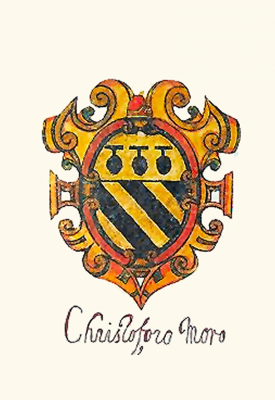 the round things may be pomegranates
the round things may be pomegranatesthis is his portrait
Dick
-
-
-
-
Thanks Carl and Steven. I have gone back and looked through my picture bank and found some good detail on the disposition of the grapnel.
All of these illustrations seem to show the chain being led into the floor of the forecastle, not the hawse holes (I will change this)
The nice chain, Steven, was a leftover from a kit that I trashed. I waste nothing.
Certainly hooks are seen on later warship carrack yard ends but are not seen on these early carracks.
I remain to be convinced that the grapnels were designed for offensive use against other ships except in extreme emergency.
I believe I now have the answer. Grapnels were a common form of anchor for dhows and other vessels of the Indian ocean and were used to assist mooring in tidal estuaries or tidal flats at low tide. They were also used to help haul the dhow out to deep water at high tide. (Clifford Hawkins: The Dhow, an illustrated history of the dhow and its world). the dhows suspended the grapnels from the bowsprit and sometimes used chain instead of cable.I believe that this would have been the practice in the tidal lagoons such as Venice where the large anchors could not have been used (as seen in the Barbari map of Venice)
 Cheers
CheersDick
-
Dick,
Just to get some things clear ... the anchor is attached to the hull with a chain - fixed length - and is dropped with a 'cable' so it can be hauled up again ...
Thanks, Carl. I am speculating here. I am far from clear about this myself. The grapnel is only an auxiliary anchor. The main anchors are much larger. The grapnel may be used for manoeuvring the ship in harbour. I doubt it was used to grapple other ships. The grapnel chain is attached to a cable which is led into the forecastle,
maybe through the hawse holes( i dont believe this now. see posts below).The windlass could also be able to assist and the grapnel cable could be wound onto the tranversal bitt. What is the exact function of the transverse bitt and how is the main anchor cable attached to it? No detailed contemporary pictures show this detail although one picture shows what may be the anchor cable wound around the bitt. This is guesswork but I would appreciate all suggestions. Dick
Dick -
-
Just a suggestion but putting the frames external to the plug as here in my longboat http://modelshipworld.com/index.php/topic/4496-usf-essex-by-woodrat-scale-1-64-fully-framed-from-takakjian-plans/?p=142797 allows you to edge glue the planking and fix the planks on the frames. The keelson ( if dromons had them) can be morticed to hold the frames and the keel fixed over the frames.
Dick
-
Thanks, Steven. The new workshop is not fully set up but am starting to work again. I have a vague plan to do a reconstruction of that mysterious beast, the hulc (hulk, holk) once I rig the carrack. How is the dromon going?
Cheers
Dick
- mtaylor, CaptainSteve and GLakie
-
 3
3
-
I can appreciate the amount of research that goes into a project like this with "record-keeping" being what it was back then.

thanks, George. It's not that they kept records, they didn't. They kept secrets of shipbuilding which were handed down within the guilds. People were probably murdered to maintain these secrets
 . Cheers Dick
. Cheers Dick- CaptainSteve, GLakie, mtaylor and 1 other
-
 4
4
-
This is as close as I can get to how the forecastle is depicted in the original drawing. Note the asymmetry (foremast not yet stepped). The bowsprit sticks out over the starboard rail of the forecastle. Again, the carpentry is crude and appears temporary.
the forecastle from aft. There were no crew quarters. They slept where they could find shelter. Hammocks were unknown.


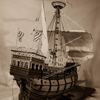
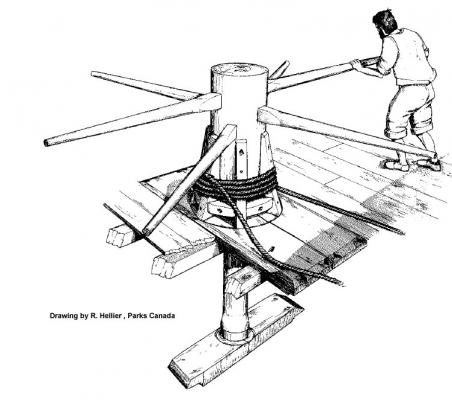
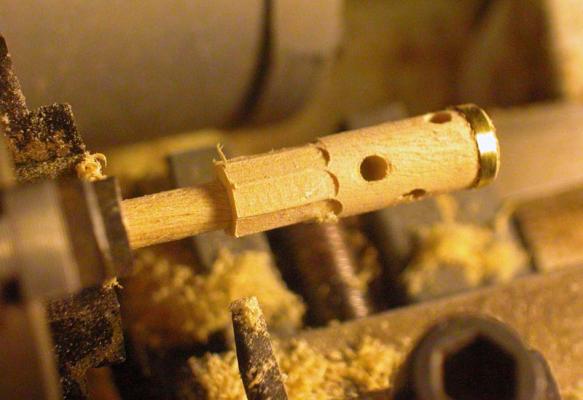
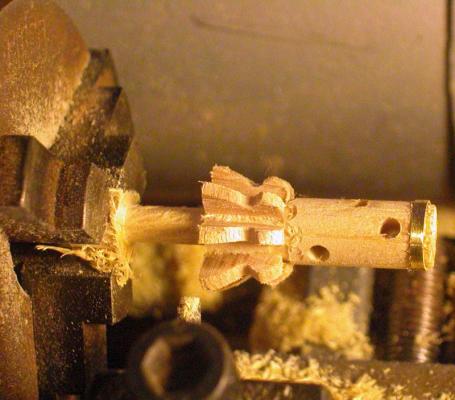
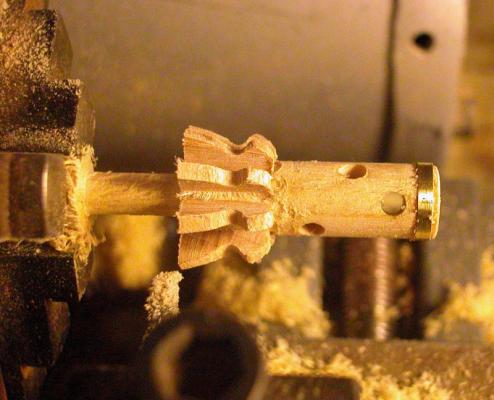
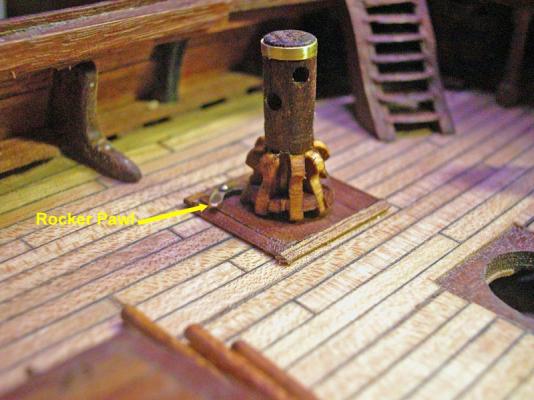
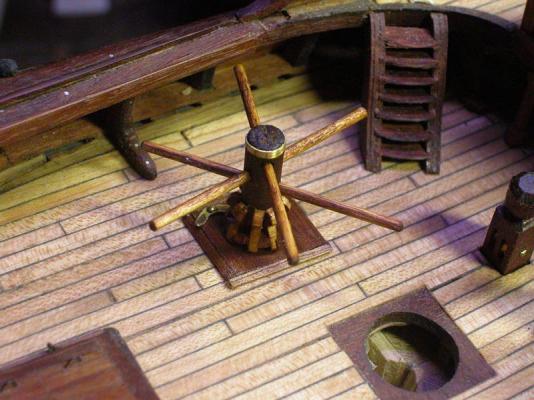

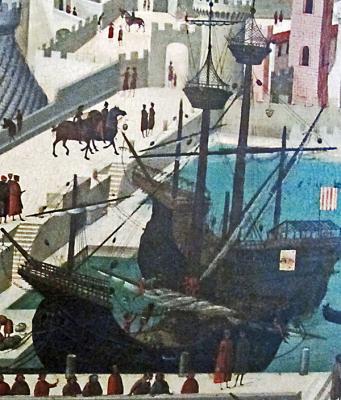
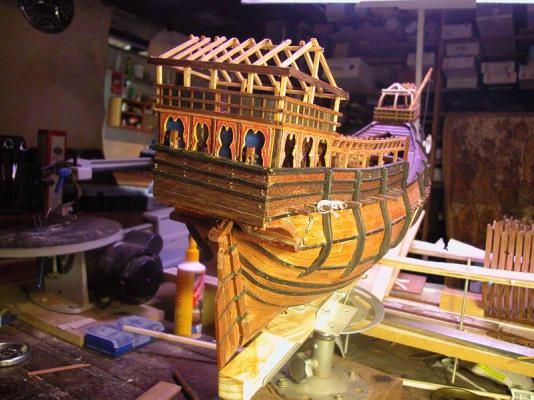
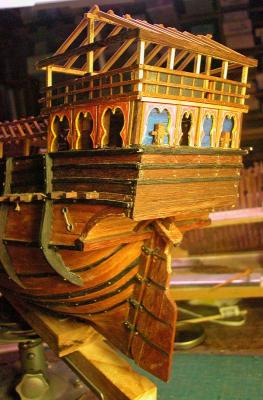
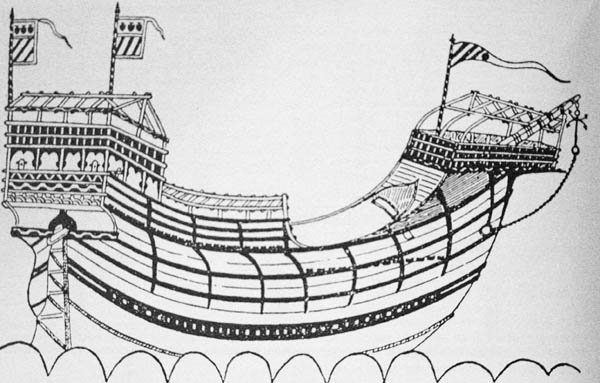
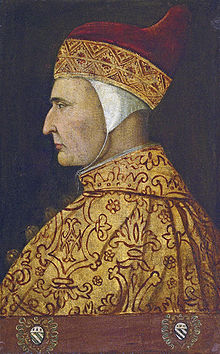
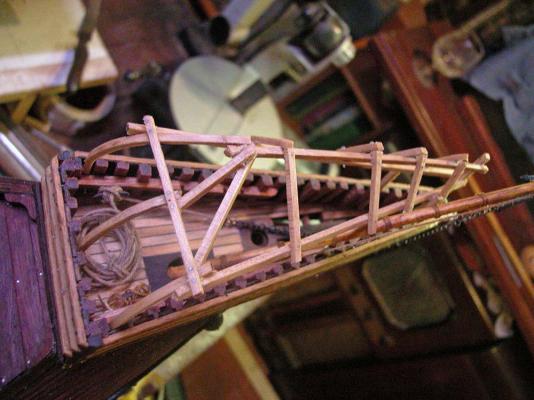
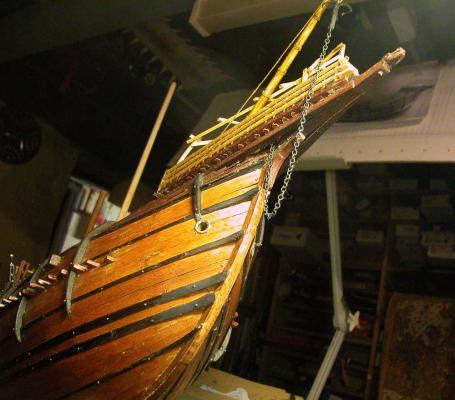
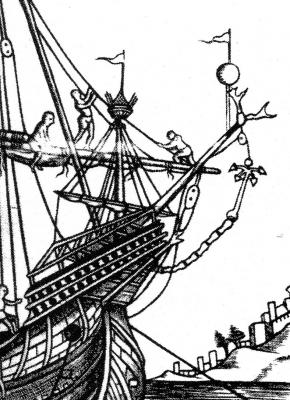
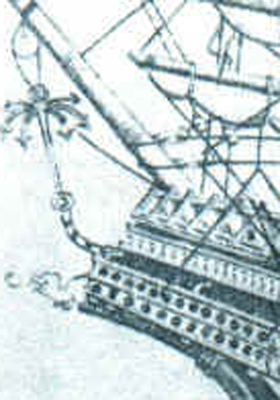
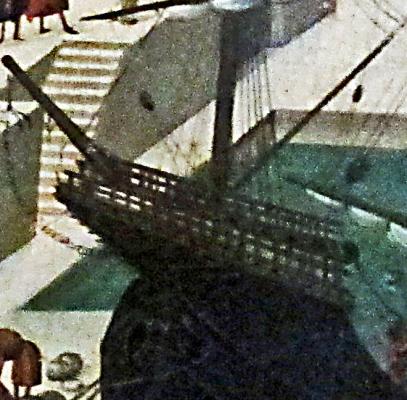
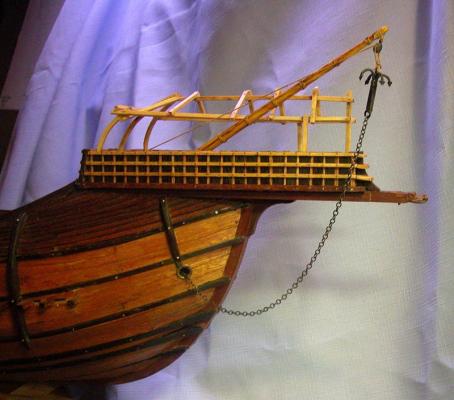
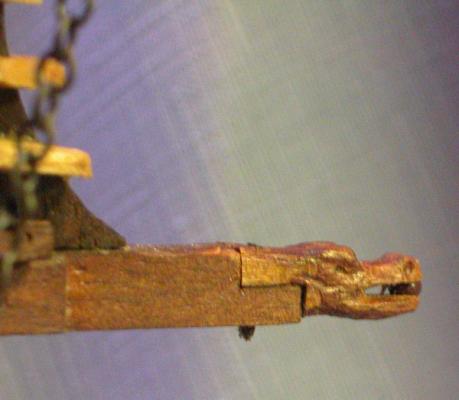
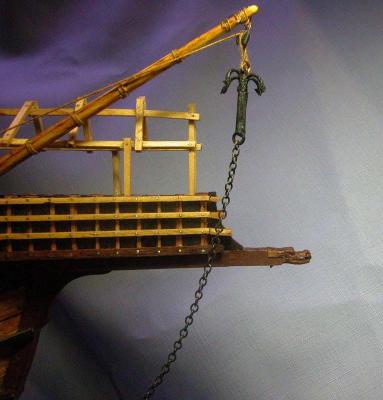
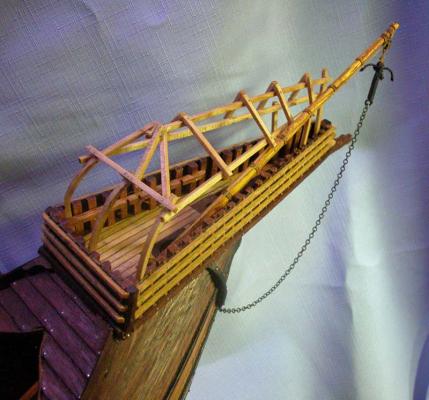
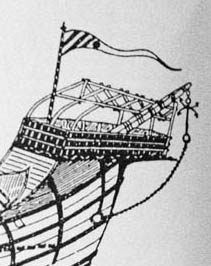
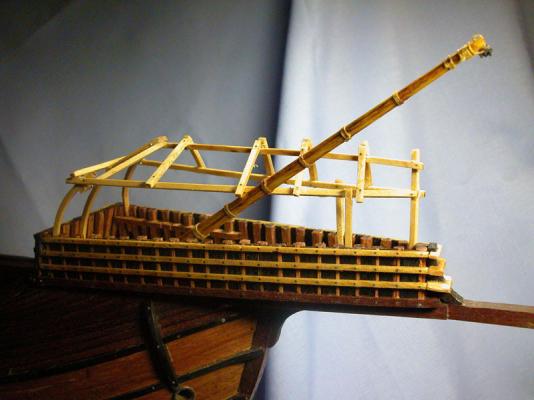
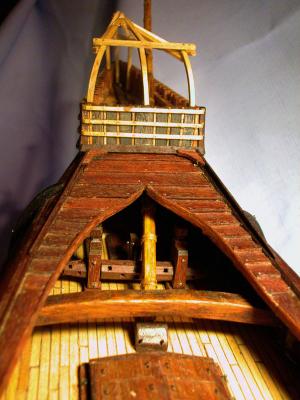
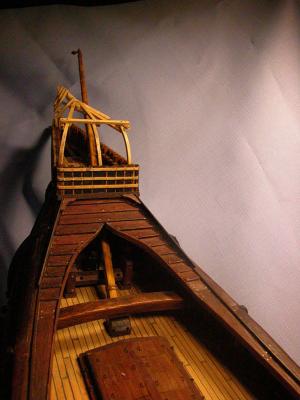
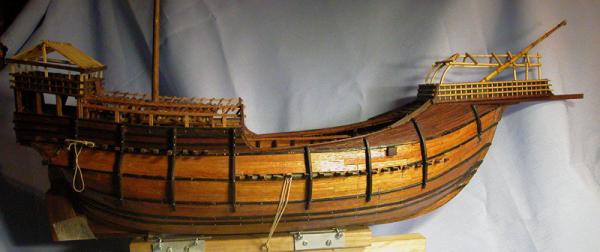

Venetian Carrack or Cocha by woodrat - FINISHED - 1/64
in - Subjects built Up to and including 1500 AD
Posted
the three iron rings were I believe used for shipping the rudder and afterwards to attach rudder preventers
A preventer is rigged
A second preventer is led into the stern